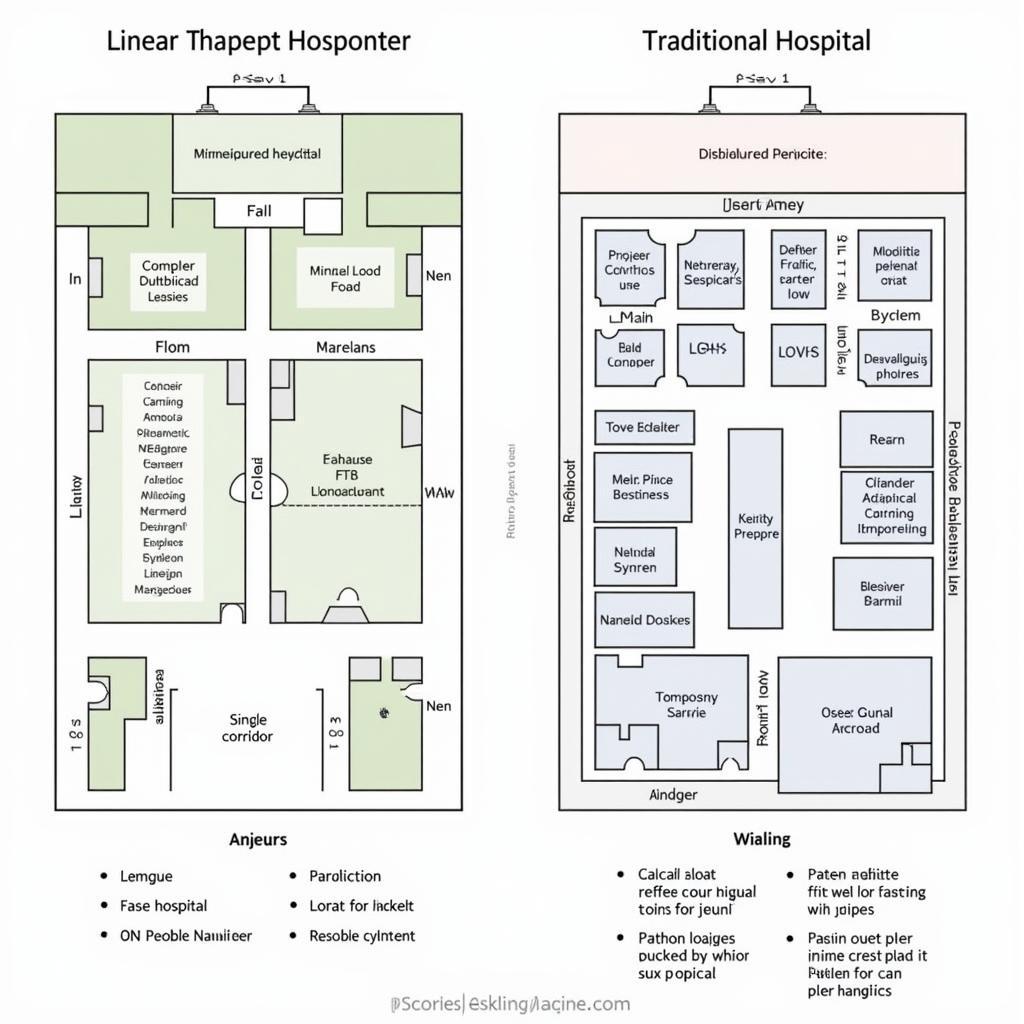The concept of a “Linear Hospital” is gaining traction in modern healthcare design. It represents a shift away from traditional, sprawling hospital layouts towards a more streamlined and efficient approach. But what exactly does it mean, and what are the implications for patients and healthcare providers? This article delves into the intricacies of the linear hospital model, exploring its benefits, challenges, and potential to revolutionize the patient experience.
What Defines a Linear Hospital?
A linear hospital is characterized by its long, narrow layout, often resembling a single corridor or a series of interconnected corridors. This design prioritizes efficient patient flow and departmental organization, placing related departments in close proximity to each other. Think of it like a well-organized assembly line, where patients move seamlessly from one stage of care to the next. This contrasts sharply with traditional hospital layouts, which can be labyrinthine and difficult to navigate. A linear design can minimize patient travel time, reduce staff fatigue, and improve overall operational efficiency.
 Comparing Linear and Traditional Hospital Layouts
Comparing Linear and Traditional Hospital Layouts
Benefits of the Linear Model
The benefits of a linear hospital extend beyond mere efficiency. They encompass improvements in patient care, staff satisfaction, and even infection control. Here are some key advantages:
- Enhanced Patient Flow: Reduced travel time translates to quicker access to care, particularly in time-sensitive situations.
- Improved Department Collaboration: Close proximity fosters better communication and collaboration among healthcare professionals.
- Optimized Infection Control: A linear layout can facilitate the creation of designated zones for different levels of care, minimizing the spread of infection.
- Cost-Effectiveness: Streamlined operations and reduced space requirements can lead to significant cost savings.
Challenges and Considerations
While the linear hospital model offers numerous advantages, it’s essential to acknowledge the potential challenges:
- Flexibility: Adapting to future needs or expanding services within a linear footprint can be challenging. Careful planning is crucial to accommodate growth and technological advancements.
- Departmental Dependencies: While proximity can be beneficial, it can also create dependencies between departments. Disruptions in one area could potentially affect others. This requires robust contingency plans and flexible staffing strategies. You may want to consider how hospital bed motors might be affected in such a system.
Addressing the Challenges of Linear Design
Mitigating these challenges requires a holistic approach that considers the specific needs of each hospital and its patient population. Solutions may include:
- Modular Design: Incorporating modular components allows for greater flexibility and adaptability in the future.
- Technology Integration: Leveraging technology, such as telehealth and remote monitoring, can optimize patient flow and reduce the need for physical space. How might what is the imu unit in a hospital play a part in this?
- Staff Training: Investing in comprehensive staff training is essential to ensure seamless transitions and effective communication within the linear model. Knowing how to support someone after psychiatric hospital is crucial.
“A well-designed linear hospital can significantly improve the patient experience,” says Dr. Amelia Carter, a leading healthcare architect. “By optimizing patient flow and facilitating collaboration, this model has the potential to transform the way we deliver care.”
Conclusion: The Future of Linear Hospitals
The linear hospital model represents a promising direction for healthcare design. By prioritizing efficiency, collaboration, and patient-centered care, this innovative approach offers a viable solution to many of the challenges facing modern hospitals. While careful planning and execution are crucial to address potential challenges, the linear hospital has the potential to revolutionize the healthcare landscape, creating a more efficient and patient-friendly environment. With proper considerations for future growth and technological integration, the linear hospital model holds significant promise for the future of healthcare. If you or a loved one has suffered hospital car accident injuries, understanding the layout of the facility can be beneficial.
“Adaptability is key,” adds Dr. Carter. “The most successful linear hospitals will be those that can evolve and adapt to the changing needs of the healthcare industry.”
When considering drive hospital bed parts, the linear design can impact efficiency and access.
When you need support, please contact us at Phone Number: 02437655121, Email: [email protected] Or visit us at: No. 298 Cau Dien Street, Minh Khai, Bac Tu Liem, Hanoi, Vietnam. We have a 24/7 customer care team.